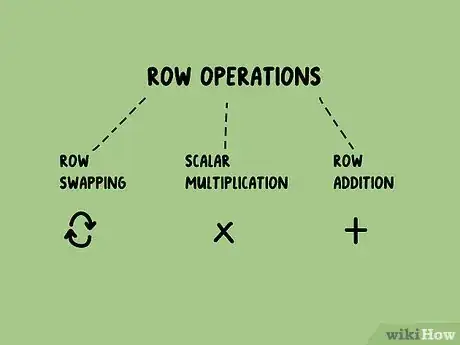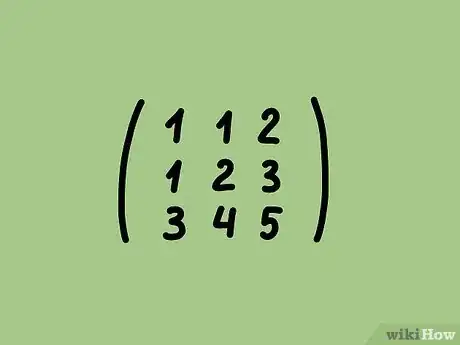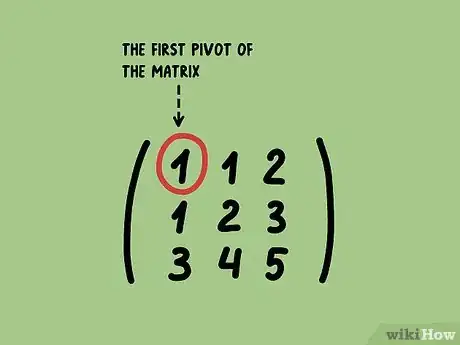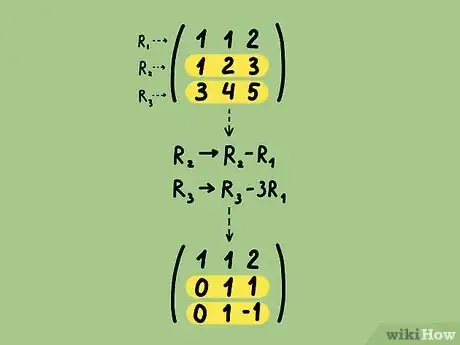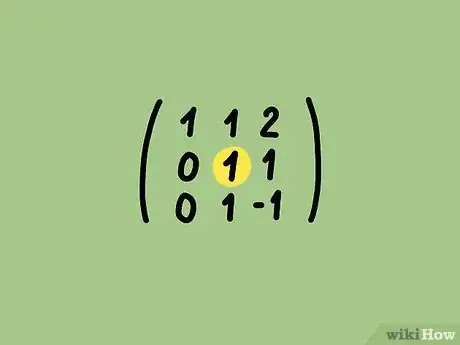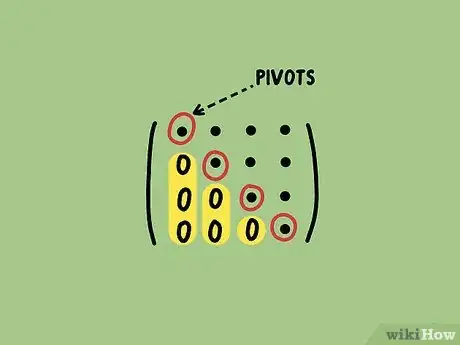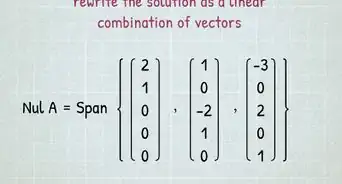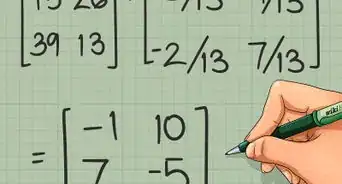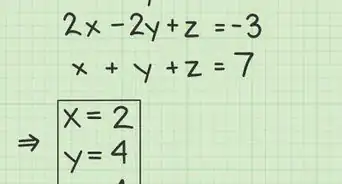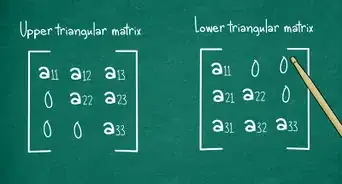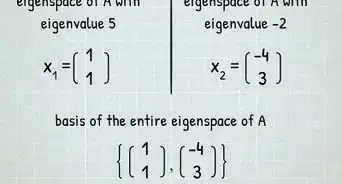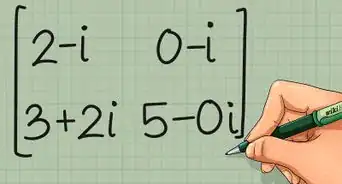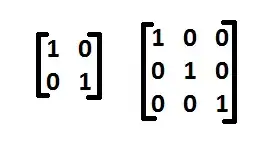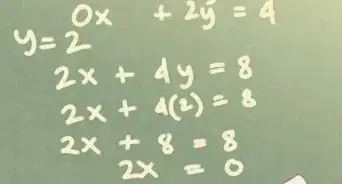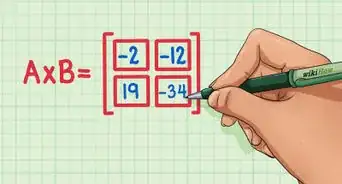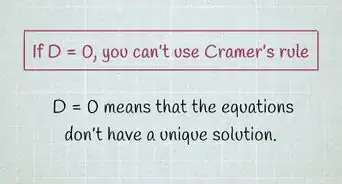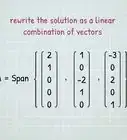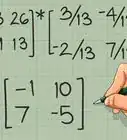X
wikiHow is a “wiki,” similar to Wikipedia, which means that many of our articles are co-written by multiple authors. To create this article, 12 people, some anonymous, worked to edit and improve it over time.
There are 7 references cited in this article, which can be found at the bottom of the page.
This article has been viewed 239,399 times.
Learn more...
The row-echelon form of a matrix is highly useful for many applications. For example, it can be used to geometrically interpret different vectors, solve systems of linear equations, and find out properties such as the determinant of the matrix.
Steps
-
1Understand what row-echelon form is. The row-echelon form is where the leading (first non-zero) entry of each row has only zeroes below it. These leading entries are called pivots, and an analysis of the relation between the pivots and their locations in a matrix can tell much about the matrix itself. An example of a matrix in row-echelon form is below.[1]
-
2Understand how to perform elementary row operations. There are three row operations that one can do to a matrix.[2]
- Row swapping.
- Scalar multiplication. Any row can be replaced by a non-zero scalar multiple of that row.
- Row addition. A row can be replaced by itself plus a multiple of another row.
Advertisement -
3Begin by writing out the matrix to be reduced to row-echelon form.[3]
-
4Identify the first pivot of the matrix. The pivots are essential to understanding the row reduction process. When reducing a matrix to row-echelon form, the entries below the pivots of the matrix are all 0.[4]
- For our matrix, the first pivot is simply the top left entry. In general, this will be the case, unless the top left entry is 0. If this is the case, swap rows until the top left entry is non-zero.
- By their nature, there can only be one pivot per column and per row. When we selected the top left entry as our first pivot, none of the other entries in the pivot's column or row can become pivots.
-
5Perform row operations on the matrix to obtain 0's below the first pivot.[5]
- For our matrix, we want to obtain 0's for the entries below the first pivot. Replace the second row with itself minus the first row. Replace the third row with itself minus three times the first row. These row reductions can be succinctly written as and
-
6Identify the second pivot of the matrix. The second pivot can either be the middle or the middle bottom entry, but it cannot be the middle top entry, because that row already contains a pivot. We will choose the middle entry as the second pivot, although the middle bottom works just as well.[6]
-
7Perform row operations on the matrix to obtain 0's below the second pivot.
- This matrix is in row-echelon form now.
-
8In general, keep identifying your pivots. Row-reduce so that the entries below the pivots are 0.[7]
Advertisement
Community Q&A
-
QuestionWhy aren't column operations used to reduce a matrix in its echelon form?
 Community AnswerAt a fundamental level, matrices are objects containing the coefficients of different variables in a set of linear expressions. Each row is for a single expression, and each column is for a single variable. When solving sets of equations, we can combine equations by adding or subtracting the equations, or multiplying them by a factor; it wouldn't make sense to multiply the coefficients of a single variable in all the equations by a number, or subtract the coefficient of one variable from that of another variable in all the equations. Hence, we perform operations on rows (coefficients in expressions), not on columns (coefficients of variables).
Community AnswerAt a fundamental level, matrices are objects containing the coefficients of different variables in a set of linear expressions. Each row is for a single expression, and each column is for a single variable. When solving sets of equations, we can combine equations by adding or subtracting the equations, or multiplying them by a factor; it wouldn't make sense to multiply the coefficients of a single variable in all the equations by a number, or subtract the coefficient of one variable from that of another variable in all the equations. Hence, we perform operations on rows (coefficients in expressions), not on columns (coefficients of variables). -
QuestionHow do you find the rank of a matrix by row echelon form?
 Community AnswerThe rank of a matrix is the dimension of the vector space spanned by the columns. So the number of pivots equals the rank. The number of non-zero rows also equals the rank.
Community AnswerThe rank of a matrix is the dimension of the vector space spanned by the columns. So the number of pivots equals the rank. The number of non-zero rows also equals the rank. -
QuestionCan my answer in row echelon form differ?
 Community AnswerYes, but there will always be the same number of pivots in the same columns, no matter how you reduce it, as long as it is in row echelon form. The easiest way to see how the answers may differ is by multiplying one row by a factor. When this is done to a matrix in echelon form, it remains in echelon form.
Community AnswerYes, but there will always be the same number of pivots in the same columns, no matter how you reduce it, as long as it is in row echelon form. The easiest way to see how the answers may differ is by multiplying one row by a factor. When this is done to a matrix in echelon form, it remains in echelon form.
Advertisement
References
- ↑ https://stattrek.com/matrix-algebra/echelon-form.aspx
- ↑ https://people.richland.edu/james/lecture/m116/matrices/matrices.html
- ↑ https://textbooks.math.gatech.edu/ila/row-reduction.html
- ↑ https://math.berkeley.edu/~arash/54/notes/01_02.pdf
- ↑ https://stattrek.com/matrix-algebra/echelon-transform.aspx
- ↑ https://math.berkeley.edu/~arash/54/notes/01_02.pdf
- ↑ https://people.richland.edu/james/lecture/m116/matrices/pivot.html
About This Article
Advertisement


